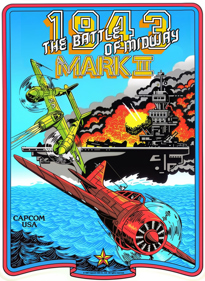Overview
Story & Game Mechanics:
1943: The Battle of Midway Mark II is a vertical scrolling shooter released by Capcom in June of 1988 in Japan as 1943: Kai. An update of 1943, it is the third game of the 19XX series. The title translates to "1943 Modified - Midway Naval Battle". The game was officially only released in Japan, though a North American localization surfaced in recent years.***
Game play changes from 1943 include:
1.1. the biplane being replaced by a P-38;
1.2. the level count reduced from 16 to 10;
1.3. weapon selection available now includes 'wingmen' option and laser;
1.4. laser special weapon no longer requires a hidden code;
1.5. every weapon can now be individually powered-up by picking up the same icon twice; and
1.6. increased difficulty.
Graphical changes from 1943 include:
2.1. new soundtrack, with different beat and tempo;
2.2. more over-the-top weaponry and less realistic planes; and
2.3. altered background colors (some stages have a red sea).
Development History & Unanswered Questions:
The lead developer was Yoshiki Okamoto. The game ran on the "Captain Commando Hardware" dual Z80 CPU platform similar to what was used on Commando and Black Tiger.
***It is not clear whether the western localization (Mark II) was programmed internally by Capcom, but evidence surfacing in the last decade seem to suggest it. The western localization was previously believed to be a hack.
The original 1943 arcade game had a 90 day warranty and often had a defective TMM2063 RAM module. US venders returning malfunctioning PCBs back to Japan for repair more than likely would have received reliable 1943 Kai PCBs with a US localization of 1943 Kai (1943 Mark II) because trouble-shooting and repairing PCBs would have been cost prohibitive.
Supporting this:
3.1. A Capcom PCB of 1943 Midway Mark II was found and dumped in 2016;
3.2. The diagonal "The Battle of Midway" logo that was unique to this version was used in a prototype, suggesting the programmer was a Capcom employee; and
3.3. An unused "Mark II" place holder was found in the official 1943 Kai ROM.
All of this suggests that a USA localization program likely existed out of necessity, even if there was never an advertised release.






























